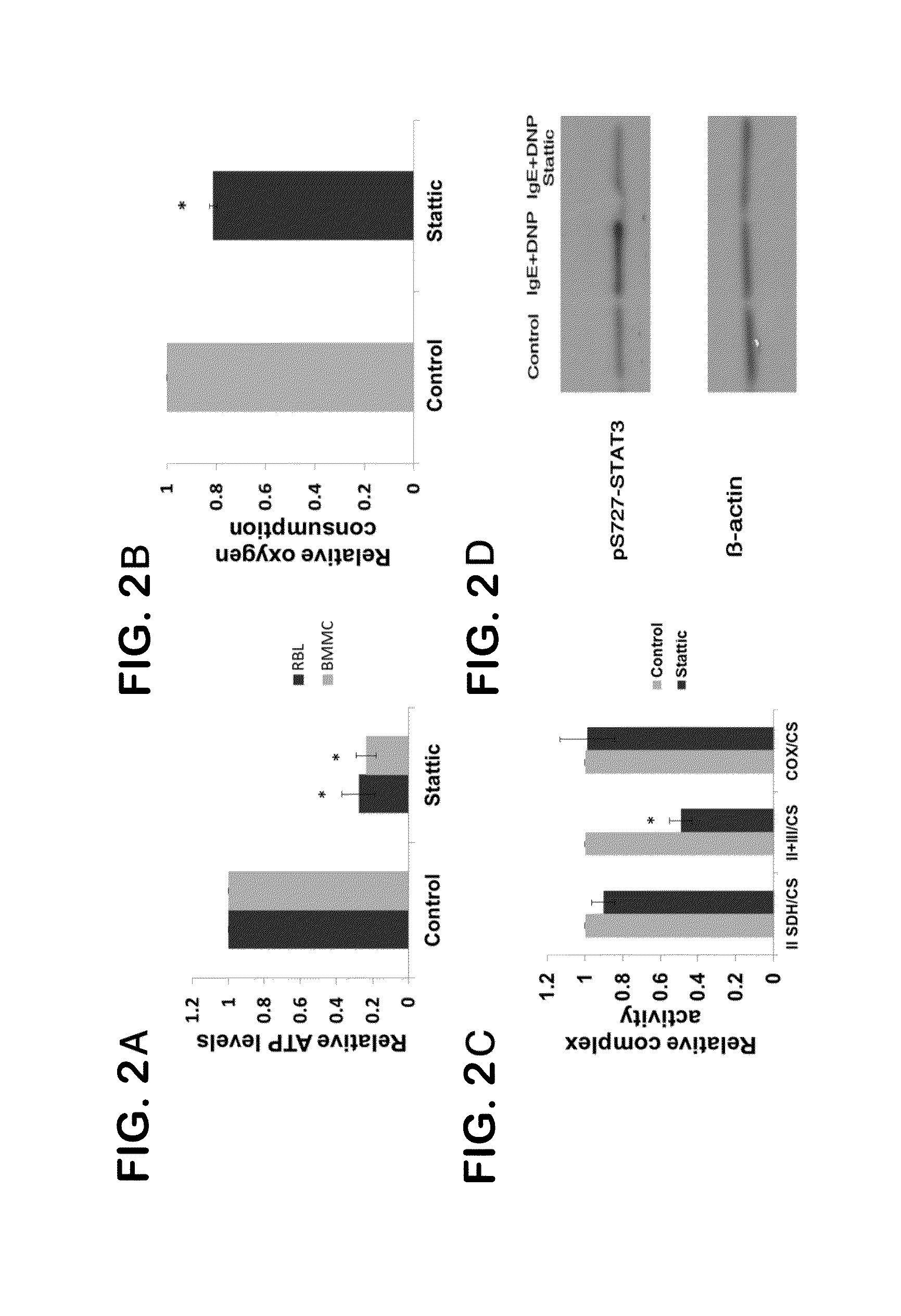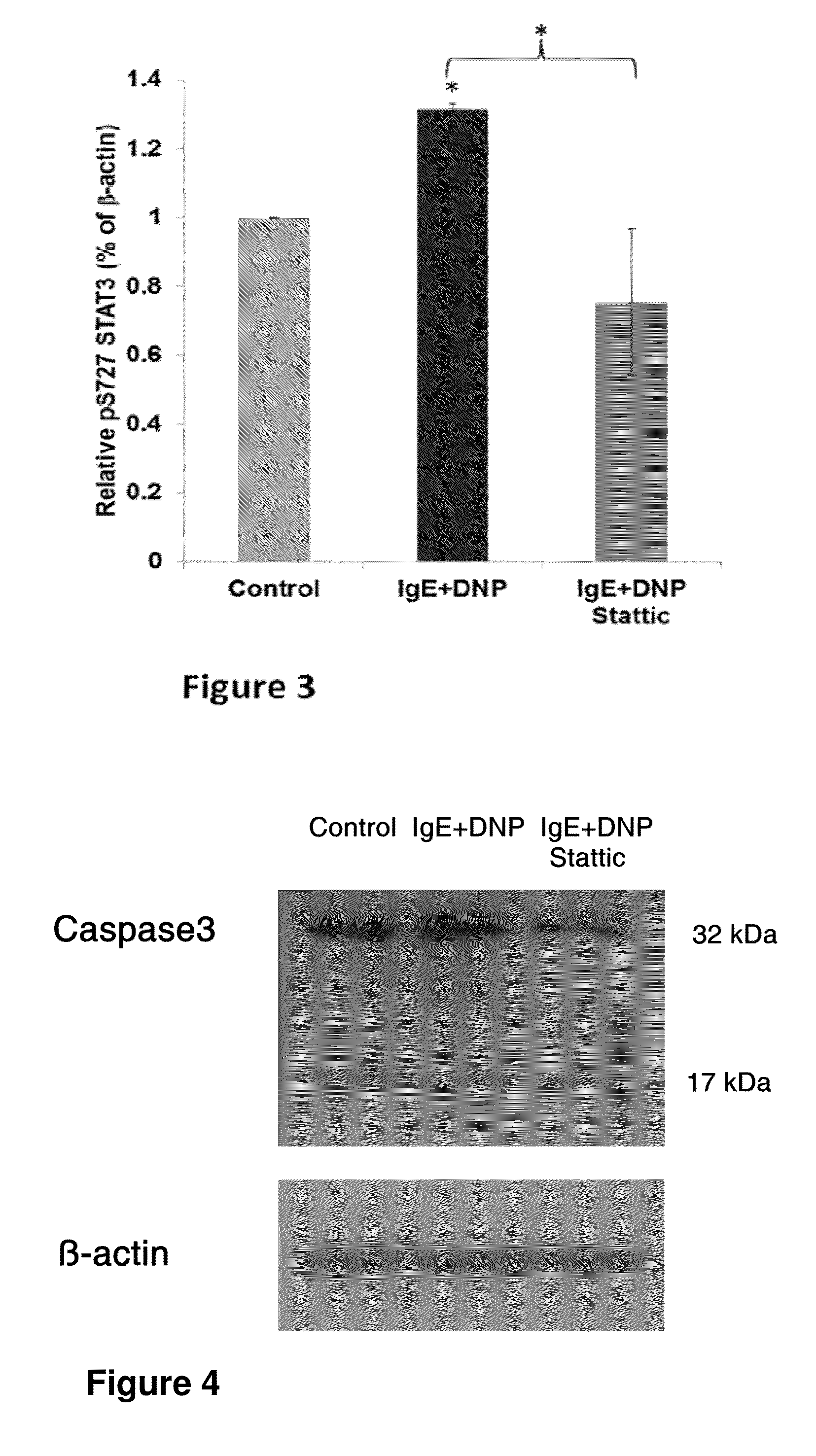Inhibitors of mitochondrial stat3 and uses thereof in modulation of mast cell exocytosis
- Summary
- Abstract
- Description
- Claims
- Application Information
AI Technical Summary
Benefits of technology
Problems solved by technology
Method used
Image
Examples
example 1
Mitochondrial ATP and Mast Cell Exocytosis
[0446]In order to determine whether mitochondrial ATP produced by OXPHOS is involved in mast cell degranulation, glycolysis was prevented and β-hexosaminidase release was determined Rat basophil leukemia (RBL) cells and bone marrow derived mast cells (BMMC) were cultured for 24 h in a glucose-free, OXPHOS dependent medium supplemented with dialyzed serum as an energy source or in complete medium used as control. These cells were activated by 2 h incubation with IgE followed by 30 min incubation with DNP-BSA. As shown in FIG. 1A, no significant change in degranulation was observed between these two groups indicating that the major part of the energy for degranulation is derived from mitochondrial ATP. The effect of immunological activation on mitochondrial ATP levels was determined in immunologically activated RBL cells grown in glucose-free medium (FIG. 1B). The ATP content was determined after 5 min incubation with DNP-BSA in order to deter...
example 2
Effect of STAT3 Inhibition on Mitochondrial ATP Production and Oxygen Consumption
[0447]STAT3 and its serine 727 phosphorylated form were previously reported to regulate mitochondrial ATP production in a variety of cells.12-14 Thus, next we determined the role if any played by mitochondrial STAT3 in mast cell function.
[0448]In order to inhibit STAT3 and distinguish between its effect on transcription and that on the modulation of mitochondrial activities, RBL and BMMC were incubated with the STAT3 inhibitor, Stattic 24 for 20 min (60 μM dissolved in 100% DMSO), a time frame which should not allow protein synthesis of STAT3 target genes. Control cells were treated with the same volume of DMSO alone. The effects of STAT3 inhibition on ATP levels, oxygen consumption and Electron Transfer Chain (ETC) activity (as indicators of OXPHOS activity) were determined. As shown in FIG. 2A-C, STAT3 inhibition resulted in a significant reduction in ATP levels (72.0±9.0%; p<0.05), oxygen consumption...
example 3
The Role Played by STAT3 in Mast Cell Function
[0449]In order to further explore the effect of mitochondrial STAT3 on mast cell function, RBL cells were incubated for 20 min with 60 μM Stattic or DMSO alone (control) followed by determination of degranulation levels and TNF-α secretion. β-hexosaminidase release and TNF-α secretion in control cells were respectively 28.9±2.7% and 23.3±5.1 μg / ml (FIG. 5A-B). Incubation with Stattic completely abolished both mast cell 3-hexosaminidase release and TNF-α secretion (p<0.05). The degranulation was also totally abolished by 5 min incubation with Stattic (data not shown). This effect on IgE-Ag mediated β-hexosaminidase release of RBL cells was found to be concentration dependent (FIG. 6). Stattic treatment of immunologically activated BMMCs achieved similar results (FIGS. 5A&C). Granzyme B secretion was also greatly reduced (FIG. 5D). Further experiments with an additional STAT3 inhibitor C188-9 25 were carried out in order to confirm the sel...
PUM
| Property | Measurement | Unit |
|---|---|---|
| Lipophilicity | aaaaa | aaaaa |
Abstract
Description
Claims
Application Information
 Login to View More
Login to View More - R&D
- Intellectual Property
- Life Sciences
- Materials
- Tech Scout
- Unparalleled Data Quality
- Higher Quality Content
- 60% Fewer Hallucinations
Browse by: Latest US Patents, China's latest patents, Technical Efficacy Thesaurus, Application Domain, Technology Topic, Popular Technical Reports.
© 2025 PatSnap. All rights reserved.Legal|Privacy policy|Modern Slavery Act Transparency Statement|Sitemap|About US| Contact US: help@patsnap.com



